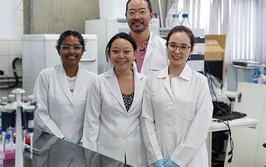A Little “Light” Reading
Presenting the latest spectroscopic research in bite-sized chunks
Root of the Matter
A recent proof-of-concept study analyzed the impact of sodium hypochlorite – the medication of choice for root canal therapy – on dental collagen. FTIR spectroscopy confirmed that the compound causes degradation in the collagen structure. Another reason to take good care of your teeth…
Bad Blood
Raman continues to make its mark in forensic science; Igor Lednev and Kyle Doty (University of Albany, New York, USA) successfully distinguished between chronological ages of blood donors in a new preliminary study. Unlike sex or race, age is something that clearly cannot be determined through DNA profiling.
Lucky in Lava
Spectroscopy took a dive lately, when researchers used LIBS to discriminate between samples of rock taken from various volcanoes. Able to identify different regions and sources, handheld LIBS could be a viable option in the field when analyzing and dating geological samples.
To the Bone
Vanderbilt University Medical Center researchers have successfully used Raman spectroscopy to analyze collagen integrity in bones – meeting the need for a non-destructive means to diagnose brittle bone disease.
Free-from Fries
When the chips are down… it looks like spatially resolved spectroscopy can detect it. Lien Smeesters and his colleagues from the Vrije Universiteit Brussel have developed a new laser scanning technique to find out which potatoes have the lowest amounts of acrylamide – making them most suitable for the production of fries. The technology can scan tons of potatoes per hour.
Baby Brains
MRI scans can check for brain damage in newborn babies, but doctors often have to wait several days to perform them. However, a team at University College London have discovered a possible alternative that allows earlier screening and treatment – broadband near-infrared spectroscopy. A clinical trial will soon be underway.
Find it in Your Heart
Could NIR spectroscopy identify patients at risk from angina and acute coronary syndrome? When combined with intravascular ultrasound (IVUS), a team headed by Ron Waksman (MedStar Heart Institute) discovered NIRS was capable of identifying lipid-rich plaque, which is associated with increased risk of certain cardiovascular diseases.
A former library manager and storyteller, I have wanted to write for magazines since I was six years old, when I used to make my own out of foolscap paper and sellotape and distribute them to my family. Since getting my MSc in Publishing, I’ve worked as a freelance writer and content creator for both digital and print, writing on subjects such as fashion, food, tourism, photography – and the history of Roman toilets.

















